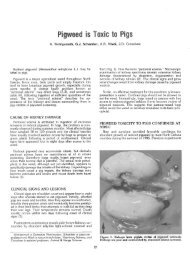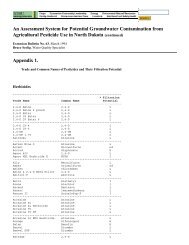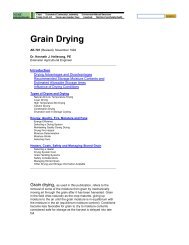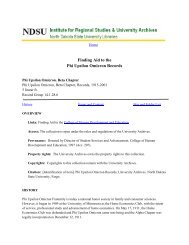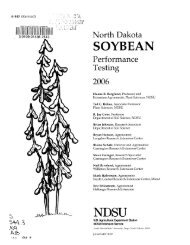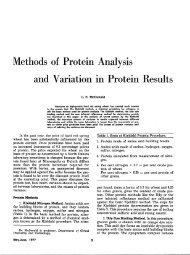Crucifer Flea Beetle Biology and Integrated Pest Management in ...
Crucifer Flea Beetle Biology and Integrated Pest Management in ...
Crucifer Flea Beetle Biology and Integrated Pest Management in ...
Create successful ePaper yourself
Turn your PDF publications into a flip-book with our unique Google optimized e-Paper software.
E-1234<strong>Crucifer</strong><strong>Flea</strong> <strong>Beetle</strong><strong>Biology</strong> <strong>and</strong><strong>Integrated</strong> <strong>Pest</strong> <strong>Management</strong><strong>in</strong> CanolaJanet J. Knodel, Crop Protection Extension SpecialistNorth Central Research Extension CenterDenise L. Olson, Research EntomologistNorth Dakota State UniversityFargo, North Dakota 58105SEPTEMBER 2002Canola is an important oilseed crop <strong>in</strong> thenorthern Great Pla<strong>in</strong>s of the United States <strong>and</strong>Canada. Canola adds crop diversity to thecropp<strong>in</strong>g rotation systems <strong>in</strong> the region.Production has <strong>in</strong>creased <strong>in</strong> the United States <strong>and</strong>Canada <strong>in</strong> response to the pest problems <strong>and</strong> lowcommodity prices of small gra<strong>in</strong>s <strong>and</strong> <strong>in</strong>creasedmarket dem<strong>and</strong> by health conscious consumersfor its high quality edible oil.The crucifer flea beetle, Phyllotreta cruciferaeGoeze, <strong>and</strong> the striped flea beetle, Phyllotretastriolata (F.) (Coleoptera: Chrysomelidae),are the most serious <strong>in</strong>sect pests of canola.Both species were <strong>in</strong>troduced from Eurasia.Phyllotreta cruciferae has become the dom<strong>in</strong>antflea beetle pest of oilseed Brassica (canola).Adult flea beetles emerge <strong>in</strong> the spr<strong>in</strong>g <strong>and</strong> feedon the cotyledons <strong>and</strong> true leaves. When theyemerge <strong>in</strong> large numbers, they can quicklydevastate a seedl<strong>in</strong>g canola field; therefore,timely detection <strong>and</strong> management of this pestis important. <strong>Flea</strong> beetle damage to oilseedBrassica crops exceeds $300 million annually<strong>in</strong> North America.
Figure 1. Adult crucifer flea beetle, Phyllotretacruciferae Goeze.DistributionThe crucifer flea beetle was <strong>in</strong>troduced <strong>in</strong>to NorthAmerica <strong>in</strong> the 1920s <strong>and</strong> is now distributed acrosssouthern Canada <strong>and</strong> the northern Great Pla<strong>in</strong>s of theUnited States, <strong>in</strong>clud<strong>in</strong>g North Dakota, South Dakota,Montana, northwestern M<strong>in</strong>nesota, Manitoba,Saskatchewan, Alberta, British Columbia, Ontario,Quebec, <strong>and</strong> New Brunswick. The crucifer flea beetleis the most common <strong>and</strong> destructive flea beetleattack<strong>in</strong>g canola.In North America, the striped flea beetle wasreported from “Carol<strong>in</strong>a” <strong>in</strong> 1801 <strong>and</strong> is nowwidespread across Canada, United States, Mexico,<strong>and</strong> South America.Figure 2. Adult striped flea beetle, Phyllotretastriolata (F.).Figure 3. <strong>Flea</strong> beetle egg.Figure 4. <strong>Flea</strong> beetle larva.IdentificationAdult<strong>Crucifer</strong> flea beetle (Figure 1): The adult is a small,oval-shaped, blackish beetle with a bright blue sheen onthe elytra, measur<strong>in</strong>g about 1/32 to 1/8 <strong>in</strong>. (2-3 mm) <strong>in</strong>length. <strong>Flea</strong> beetles have enlarged h<strong>in</strong>d femora (thighs)on their h<strong>in</strong>d legs, which they use to jump quickly whendisturbed. Their name, flea beetle, arose from thisbehavior.Striped flea beetle (Figure 2): Adults are similar <strong>in</strong>size <strong>and</strong> shape to the crucifer flea beetle, but they areblack with two yellow strips on their w<strong>in</strong>g covers.Eggs (Figure 3)Eggs are yellow, oval, <strong>and</strong> about 0.38-0.46 mm longby 0.18-0.25 mm wide, <strong>and</strong> deposited s<strong>in</strong>gly or <strong>in</strong>groups of three or four adjacent to the host plant’s roots.Larvae (Figure 4)Larvae are small approximately 1/8 <strong>in</strong>. or 3 mm,whitish, slender, cyl<strong>in</strong>drical worms. They have t<strong>in</strong>y legs<strong>and</strong> a brown head <strong>and</strong> anal plate.Pupae (Figure 5)Pupae are similar <strong>in</strong> size to the adult <strong>and</strong> white <strong>in</strong>color except for the black eyes <strong>and</strong> the free bodyappendages, which are visible later <strong>in</strong> the pupal development.Figure 5. <strong>Flea</strong> beetle pupa.2
Life Cycle (Figure 6)<strong>Crucifer</strong> flea beetles have a s<strong>in</strong>gle generation <strong>in</strong> thenorthern Great Pla<strong>in</strong>s. They overw<strong>in</strong>ter as adults <strong>in</strong> theleaf litter of shelterbelts or grassy areas <strong>and</strong> are rarelyfound <strong>in</strong> canola stubble. <strong>Beetle</strong>s emerge when temperatureswarm up to 57°F (14°C) <strong>in</strong> early spr<strong>in</strong>g. They feedon volunteer canola <strong>and</strong> weeds, such as wild mustard,<strong>and</strong> move to newly planted canola as it emerges.Depend<strong>in</strong>g on the temperature, it may take up to threeweeks for the adults to leave their overw<strong>in</strong>ter<strong>in</strong>g sites.The striped flea beetle adults usually emerge beforethe crucifer flea beetle. Warm, dry, <strong>and</strong> calm weatherpromotes flea beetle flight <strong>and</strong> feed<strong>in</strong>g throughout thefield, while simultaneously slow<strong>in</strong>g canola growth. Incontrast, cool, ra<strong>in</strong>y, <strong>and</strong> w<strong>in</strong>dy conditions reduce flightactivity, <strong>and</strong> flea beetles walk or hop lead<strong>in</strong>g to concentrations<strong>in</strong> the field marg<strong>in</strong>s. Females oviposit up to 25eggs <strong>in</strong> the soil <strong>in</strong> June. The overw<strong>in</strong>tered adultscont<strong>in</strong>ue to rema<strong>in</strong> active until late June <strong>and</strong> beg<strong>in</strong> todie off <strong>in</strong> early July. Larvae hatch from the eggs <strong>in</strong>about 12 days <strong>and</strong> feed on the secondary roots of theplant. No major effects on plant vigor from larval rootfeed<strong>in</strong>g have been noted <strong>in</strong> North Dakota. However,a yield loss of 5% from larval densities of 1/sq. <strong>in</strong>.(0.16/sq. cm) has been recorded <strong>in</strong> Manitoba. Larvaepass through three <strong>in</strong>stars <strong>and</strong> complete their development<strong>in</strong> 25 to 34 days by form<strong>in</strong>g small earthen puparium.The pupal stage lasts for about seven to n<strong>in</strong>edays, usually <strong>in</strong> early to mid-July. The new generationof adults emerge from the puparium beg<strong>in</strong>n<strong>in</strong>g <strong>in</strong> lateJuly until early September <strong>and</strong> feed on the epidermisof green foliage <strong>and</strong> pods of canola, mustard, <strong>and</strong>cruciferous weeds (Figure 7). The crop is usuallymature enough that feed<strong>in</strong>g damage is m<strong>in</strong>imal. In earlyfall beetles move to overw<strong>in</strong>ter<strong>in</strong>g sites.Figure 6. Life cycle of the <strong>Crucifer</strong> flea beetle.FallSummer generationof adults July - Oct.W<strong>in</strong>terSpr<strong>in</strong>gOverw<strong>in</strong>ter<strong>in</strong>g adultsemergeADULTPUPAJuly - AugustSummerEGGMay - JuneLARVAJune - July3
HostsThe crucifer flea beetle has a narrow host range restrictedto plants primarily <strong>in</strong> the mustard family(<strong>Crucifer</strong>ae). Other plant families attacked are the caperfamily (Capparidaceae), the nasturtium family(Tropaeolaceae), <strong>and</strong> the marshflower family(Limnanthaceae). Interest<strong>in</strong>gly, all of the flea beetlesprefer plant families that produce mustard oil (or allylisothiocyanate), which is a known aggregation pheromoneof the crucifer flea beetle. The most-preferredhosts are <strong>in</strong> the genus Brassica (<strong>Crucifer</strong>ae), which<strong>in</strong>clude the major agricultural host attacked by fleabeetle, oil rapeseed or Argent<strong>in</strong>e canola (B. napus) <strong>and</strong>Polish canola (B. rapa/campestris). Mustard (Brassicaspp.) <strong>and</strong> crambe (Crambe abyss<strong>in</strong>ica) are also susceptibleto flea beetle attack but not preferred over canola.Other hosts that flea beetles will attack <strong>in</strong> the gardensett<strong>in</strong>g are cabbage, turnip, cauliflower, kale, Brusselsprouts, horseradish, <strong>and</strong> radish. Some weeds attacked<strong>in</strong> the cruciferous group are flixweed, field pennycress,peppergrass, <strong>and</strong> wild mustard.Figure 7. The new generation of flea beetles feed<strong>in</strong>g onthe green foliage <strong>and</strong> pods of canola <strong>in</strong> mid-July until earlySeptember.Crop DamageThe greatest crop loss occurs dur<strong>in</strong>g the spr<strong>in</strong>g whenflea beetle feed on cotyledons <strong>and</strong> first true leavesdur<strong>in</strong>g the first two weeks after emergence. Leaf tissueof the cotyledons die around adult flea beetle feed<strong>in</strong>gsites produc<strong>in</strong>g a shot-hole appearance <strong>and</strong> necrosis(Figure 8). Under severe pressure <strong>in</strong> North Dakota, fleabeetles have been recorded attack<strong>in</strong>g the grow<strong>in</strong>g po<strong>in</strong>t(meristem tissue), kill<strong>in</strong>g the plant.Adult feed<strong>in</strong>g on young seedl<strong>in</strong>gs results <strong>in</strong> reducedcrop st<strong>and</strong>s <strong>and</strong> plant growth, delayed maturity, <strong>and</strong>lower seed yield. When flea beetle populations are large<strong>and</strong> warm, sunny, dry, calm conditions favor feed<strong>in</strong>g,fields can be <strong>in</strong>fested quickly <strong>and</strong> canola seedl<strong>in</strong>gs die.Figure 8. Canola seedl<strong>in</strong>g damage,pitt<strong>in</strong>g caused by flea beetle feed<strong>in</strong>g (top)<strong>and</strong> undamaged seedl<strong>in</strong>g (bottom).4
St<strong>and</strong> losses may result <strong>in</strong> hav<strong>in</strong>g to reseed the field.Less severe <strong>in</strong>festations may result <strong>in</strong> stunted plants,uneven st<strong>and</strong>s <strong>and</strong> maturation, <strong>and</strong> harvest problems.When weather conditions are cool, wet, <strong>and</strong> w<strong>in</strong>dy, fleabeetles may creep slowly <strong>in</strong>to the field <strong>and</strong> concentratefeed<strong>in</strong>g on the field edges. Spr<strong>in</strong>g feed<strong>in</strong>g activityoccurs from May through June.Dur<strong>in</strong>g the summer months, the larvae feed on thesecondary root hairs, but only a negligible effect onyield loss or vigor has been observed. The summergeneration of adult flea beetles emerge after mid-July<strong>and</strong> feed on develop<strong>in</strong>g pods (Figure 7). Usually theupper or younger pods <strong>and</strong> later seeded crops are mostimpacted. This feed<strong>in</strong>g damage results <strong>in</strong> poor seed fill,premature pod dry<strong>in</strong>g, shriveled seeds, or pod shatter<strong>in</strong>g,<strong>and</strong> provides an entry po<strong>in</strong>t for fungal growthwith<strong>in</strong> pods <strong>in</strong> damp weather.<strong>Integrated</strong><strong>Pest</strong> <strong>Management</strong>In the spr<strong>in</strong>g, overw<strong>in</strong>ter<strong>in</strong>g flea beetle adultsemerge, locate, feed on, <strong>and</strong> damage emerg<strong>in</strong>g canolaplants. To effectively manage flea beetles <strong>and</strong> otherpests of canola, producers should use an <strong>Integrated</strong><strong>Pest</strong> <strong>Management</strong> (IPM) program. An IPM approachuses multiple strategies to control flea beetles,m<strong>in</strong>imizes <strong>in</strong>puts, conserves the natural enemies ofpests, <strong>and</strong> reduces the negative impacts of pesticideson the environment. This type of approach is alsothe most economical. Canola fields should bemonitored on a regular basis to determ<strong>in</strong>e thelevel of <strong>in</strong>festation <strong>and</strong> damage.Monitor<strong>in</strong>g <strong>and</strong> Field Sampl<strong>in</strong>g<strong>Flea</strong> beetles overw<strong>in</strong>ter as adults <strong>and</strong> become activedur<strong>in</strong>g early spr<strong>in</strong>g. Field monitor<strong>in</strong>g for flea beetleactivity should beg<strong>in</strong> <strong>in</strong> newly emerged canola fieldsdur<strong>in</strong>g May <strong>and</strong> June when air temperatures reach 57°F(14°C). Commercial, 4x6 <strong>in</strong>. yellow sticky traps (Figure10) can be used for monitor<strong>in</strong>g population levels, butthey do not <strong>in</strong>dicate the need for control actions. Assessthe canola field for presence of flea beetles <strong>and</strong> theirfeed<strong>in</strong>g damage dur<strong>in</strong>g the first 14 days after cropemergence, or until plants have reached the 4-leaf stage.Fields should be checked daily to identify damage as itdevelops <strong>and</strong> to make timely management decision.<strong>Beetle</strong>s are most active dur<strong>in</strong>g sunny, warm, calm <strong>and</strong>dry weather conditions, so avoid monitor<strong>in</strong>g for fleabeetles when conditions are cool, w<strong>in</strong>dy, <strong>and</strong> damp.The amount of defoliation should be used as a guideto determ<strong>in</strong>e the need for management action. Injuryoccurs first at the field edges, particularly where ashelterbelt/grassy area borders a field. The beetlesreadily fly when temperatures exceed 64 o F (17.8 o C) <strong>and</strong>will move quickly <strong>in</strong>to the field’s <strong>in</strong>terior. To determ<strong>in</strong>ethe extent <strong>and</strong> distribution of damage, start at the fieldmarg<strong>in</strong>s <strong>and</strong> walk <strong>in</strong>to the field, select<strong>in</strong>g plants atvarious r<strong>and</strong>om <strong>in</strong>tervals. Estimate percent defoliationfor each plant selected. The economic threshold for afoliar application is when an average of 25% of thesurface area of cotyledons <strong>and</strong> first true leaves hasbeen <strong>in</strong>jured (Figure 9) <strong>and</strong> beetles are present. Ifleaf damage is less than 25% <strong>and</strong> the crop is activelygrow<strong>in</strong>g, the crop can usually recover. Watch fieldsclosely <strong>in</strong> hot, dry weather, when flea populationscan rapidly <strong>in</strong>crease.Foliar treatments must be made quickly if damageexceeds 25% defoliation. Under high beetle pressure<strong>and</strong> feed<strong>in</strong>g damage, a delay of one to two days canresult <strong>in</strong> loss of entire fields. If damage is limited toonly the edge, spray<strong>in</strong>g only part of the field may25% defoliationFigure 9. Examples of defoliation with25% defoliation on canola cotyledons be<strong>in</strong>gan economic threshold level.5
Figure 10. Yellow sticky trap used formonitor<strong>in</strong>g flea beetle populations.reduce flea beetle numbers. Apply <strong>in</strong>secticides dur<strong>in</strong>gthe sunny, warm part of the day when beetles areactively feed<strong>in</strong>g on the plants. Canola plants that havereached the 4-leaf vegetative growth stage or beyondcan tolerate more feed<strong>in</strong>g damage, unless flea beetlesare damag<strong>in</strong>g the grow<strong>in</strong>g po<strong>in</strong>t. Dur<strong>in</strong>g years whenflea beetles are abundant through June, a yield lossof about 10% can be common even when the crop isprotected with <strong>in</strong>secticidal seed treatments. Underthese conditions a later foliar treatment (21 days afterplant<strong>in</strong>g) may be necessary to protect the crop fromre-<strong>in</strong>festation.The summer generation of adults emerg<strong>in</strong>g <strong>in</strong> lateJuly <strong>and</strong> August will feed on the leaves, stems, <strong>and</strong> podsof the matur<strong>in</strong>g crop, but usually does not causeeconomic damage. Control may be necessary <strong>in</strong> latematur<strong>in</strong>g fields where large <strong>and</strong> <strong>in</strong>creas<strong>in</strong>g numbersof adults may congregate <strong>and</strong> feed on green pods.Monitor the summer adult populations <strong>in</strong> late July<strong>and</strong> August to determ<strong>in</strong>e the need for protect<strong>in</strong>g nextyear’s canola crop. If the flea beetle population isabundant <strong>in</strong> canola swaths,consider a seed treatmentfor the follow<strong>in</strong>gproductionseason.EconomicThresholdSeedl<strong>in</strong>g:25% defoliation ofcotyledons <strong>and</strong> firsttrue leaves6
Cultural ControlPlant<strong>in</strong>g DateCanola planted early from April to mid-May reducesthe risk of heat <strong>and</strong> drought stress dur<strong>in</strong>g flower<strong>in</strong>g <strong>and</strong>produces higher seed yields than canola planted fromlate May to early June. Early seed<strong>in</strong>g with good qualityseed <strong>in</strong>to a shallow, firm seed bed also reduces the riskof feed<strong>in</strong>g <strong>in</strong>jury by flea beetles to canola seedl<strong>in</strong>gs.Plant<strong>in</strong>g early <strong>and</strong> shallow helps seedl<strong>in</strong>gs emergeearlier, so plants are larger <strong>and</strong> can tolerate morefeed<strong>in</strong>g by the time flea beetle populations are large.Increased seed<strong>in</strong>g rates may also help reduce flea beetleimpact by reduc<strong>in</strong>g overall damage per plant with moreplants per unit area. In Canada, canola planted <strong>in</strong> widerrow spac<strong>in</strong>gs of 7.8-11.8 <strong>in</strong>. (20-30 cm) resulted <strong>in</strong>decreased feed<strong>in</strong>g damage per plant than narrower rowspac<strong>in</strong>gs of 4 <strong>in</strong>. (10 cm). Later planted canola may notalways avoid <strong>in</strong>vasion of the flea beetle because ofrepeated migrations <strong>in</strong>to the crop. <strong>Flea</strong> beetles cont<strong>in</strong>ueto fly actively throughout May <strong>and</strong> June. Trap data offlea beetles <strong>in</strong> the north central region of North Dakota<strong>in</strong>dicate that flight activity fluctuates throughout May<strong>and</strong> June, perhaps caused by favorable or unfavorableweather conditions.Plant<strong>in</strong>g SystemsUse of different cropp<strong>in</strong>g systems such as no-till,m<strong>in</strong>imum till, or fall dormant seed<strong>in</strong>g, may offer analternative to the traditional chemical control of fleabeetles on canola. S<strong>in</strong>ce flea beetles are more activedur<strong>in</strong>g sunny <strong>and</strong> warm days, it has been suggested thatthe different cropp<strong>in</strong>g systems may provide a lessdesirable, cooler micro-environment for flea beetleactivity. Often, flea beetle populations are lower <strong>in</strong> notillfields compared to conventional tillage fields.Dormant seeded canola may germ<strong>in</strong>ate, emerge, <strong>and</strong>reach the 4-leaf stage before significant numbers of fleabeetles emerge from overw<strong>in</strong>ter<strong>in</strong>g sites. Only 4% ofthe dormant-seeded fields <strong>in</strong> the north central region ofNorth Dakota dur<strong>in</strong>g 1999-2000 were sprayed with afoliar <strong>in</strong>secticide for flea beetle control, compared to25% of the spr<strong>in</strong>g-seeded fields, accord<strong>in</strong>g to a canolagrower survey.Crop RotationS<strong>in</strong>ce flea beetles are strong flyers <strong>and</strong> disperse overwide areas from overw<strong>in</strong>ter<strong>in</strong>g sites, crop rotation is notan effective means of manag<strong>in</strong>g flea beetles. However,crop rotation is very important <strong>in</strong> reduc<strong>in</strong>g the level ofcanola diseases like blackleg <strong>and</strong> sclerot<strong>in</strong>ia.Plant ResistanceAlthough some of the larger-seeded varieties are moreresistant to flea beetle damage due to their largeseedl<strong>in</strong>g size, no canola varieties exhibit sufficientresistance to protect aga<strong>in</strong>st flea beetle feed<strong>in</strong>g damage.Biological ControlPredators known to feed on flea beetles <strong>in</strong>clude lacew<strong>in</strong>glarvae (Chrysopa carnea), big-eyed bugs (Geocorisbullatus), the two-l<strong>in</strong>ed collops (Collops vittatus), thewestern damsel bug (Nabis alternatus) <strong>and</strong> the northernfield cricket (Gryllus pennsylvanicus). Parasitic wasps,like Microtonus vittate, are known to attack cruciferflea beetles, but the rate of parasitization is very low.Unfortunately, flea beetle populations emerge dur<strong>in</strong>ga narrow w<strong>in</strong>dow <strong>in</strong> the spr<strong>in</strong>g, <strong>and</strong> natural enemiesusually do not have enough time to negatively impactflea beetle populations.Insecticide ControlWhen flea beetle populations are large the previous fall,a seed treatment with a systemic <strong>in</strong>secticide should beapplied as a preventive tactic. About 60-70% of canolaseed <strong>in</strong> North Dakota is treated with an <strong>in</strong>secticidefungicide.Treatments provide protection aga<strong>in</strong>st fleabeetles for about seven-14 days after seedl<strong>in</strong>g emergence.<strong>Flea</strong> beetles can still reduce yield of canolagrown from treated seed by 8-10% when beetle populationsare large <strong>and</strong> canola is past the protection period.Foliar applied <strong>in</strong>secticides are effective when beetlepopulations have reached an economic threshold level<strong>and</strong> treatments are timed properly. Insecticides registeredfor flea beetle management <strong>in</strong> North Dakota as of2002 are listed <strong>in</strong> the table below. Please check with thecurrent Field Crop Insect <strong>Management</strong> Guide forupdated <strong>in</strong>secticide registrations. Insecticide users mustREAD, UNDERSTAND, <strong>and</strong> FOLLOW ALL LABELDIRECTIONS.7
Registered <strong>Flea</strong> <strong>Beetle</strong> InsecticidesDosage <strong>in</strong> ProductInsecticide Lb Ai/acre Per Acre Restrictions on UseCapture 2 EC 0.033 to 0.04 1.3 to 2.6 fl oz Reduced rate is issued as a state 2 (ee) label. Apply <strong>in</strong> aRUPm<strong>in</strong>imum of 2 gals. of f<strong>in</strong>ished spray per acre by air or <strong>in</strong> am<strong>in</strong>imum of 10 gals. per acre by ground. When apply<strong>in</strong>g by air,1 to 2 quarts of emulsified oil may be substituted for 1 to2 qts of water <strong>in</strong> the f<strong>in</strong>ished spray. Do not apply with<strong>in</strong> 35 daysof harvest.Ethyl-methyl 0.5 0.66 pt Aerial application only, us<strong>in</strong>g a m<strong>in</strong>imum of 3 gallons of waterparathion 6-3per acre. Do not apply with<strong>in</strong> 28 days of harvest. Do not enterRUPtreated fields for 3 days after application. Fields must be posted.Gaucho 10.7 - 21.3 oz For use <strong>in</strong> commercial seed treaters only. Not for use <strong>in</strong>per hundred- hopper-box, slurry-box or other seed treatment applications at,weight of seed or immediately before, plant<strong>in</strong>g.thiamethoxam 23 fl oz per For use <strong>in</strong> commercial seed treaters only. Conta<strong>in</strong>s 3 fungicidesHelix (10.3% active) hundredweight to protect aga<strong>in</strong>st diseases. There is a 30 day plant backHelix Xtra (20.7% active) of seed restriction.Methyl 0.5 0.5 pt Aerial application only, us<strong>in</strong>g a m<strong>in</strong>imum of 3 gallons water perparathion 8ECacre. Do not apply with<strong>in</strong> 25 days of harvest. Do not enterRUPtreated fields with<strong>in</strong> 48 hours after application. Fields must beposted.RUP - Restricted use pesticideAdditional SourcesCanola Connection, Canola Council of Canada,http://www.canola_council.org/Canola Production, NDSU Ext. Service CircularA-686, 1998, http://www.ext.nodak.edu/extpubs/plantsci/crops/a686w.htmNorthern Canola Growers Association,http://www.northerncanola.com/default.asp2002 Field Crop Insect <strong>Management</strong> Recommendations,NDSU Ext. Service,Circular E-1143, http://www.ext.nodak.edu/extpubs/plantsci/pests/e1143w1.htmPhotograph creditsFigures 1 <strong>and</strong> 2 were taken by Gerald Fauske,NDSU Department of Entomology.Figures 3, 4, 5 <strong>and</strong> 6 are used by permission ofSyngenta Crop Protection, Inc.Figures 7, 8, 9 <strong>and</strong> 10 were taken by Janet Knodel.For more <strong>in</strong>formation on this <strong>and</strong> other topics, see: www.ag.ndsu.nodak.eduNDSU Extension Service, North Dakota State University of Agriculture <strong>and</strong> Applied Science, <strong>and</strong> U.S. Department of Agriculture cooperat<strong>in</strong>g.Sharon D. Anderson, Director, Fargo, North Dakota. Distributed <strong>in</strong> furtherance of the Acts of Congress of May 8 <strong>and</strong> June 30, 1914. We offerour programs <strong>and</strong> facilities to all persons regardless of race, color, national orig<strong>in</strong>, religion, sex, disability, age, Vietnam era veterans status, orsexual orientation; <strong>and</strong> are an equal opportunity employer.2M-9-02This publication will be made available <strong>in</strong> alternative format upon request to people with disabilities (701) 231-7881.



